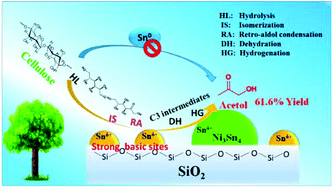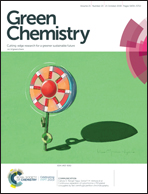Highly efficient catalytic conversion of cellulose into acetol over Ni–Sn supported on nanosilica and the mechanism study†
Abstract
Selective conversion of cellulose into high value-added C3 chemicals is a great challenge in biorefinery due to the complicated reaction process. In this work, 61.6% yield of acetol was obtained by one pot conversion of cellulose using Ni–Sn/SiO2 catalysts. A series of characterization methods including TEM, STEM-HAADF, EDS, AAS, XRD, XPS, H2-TPR, Py-FTIR, and CO2-TPD were carried out to explore the structure–activity relationship. The strong basicity of the catalysts was a key factor affecting the production of acetol. In addition, catalysts with the hydrothermally stable L-acid sites and no B-acid sites inhibited side reactions and ensured efficient conversion of cellulose into small molecules. Further studies showed that the formation of the Ni3Sn4 alloy significantly promoted the acetol production, and its weak hydrogenation activity inhibited further conversion of acetol. Noninteger valence tin species (Snδ+ and SnOx) were formed both in Ni3Sn4 and Sn/SiO2. These Sn species were the source of basic sites and the active sites for catalyzing cellulose to acetol. Under the synergistic catalysis of Sn/SiO2 and the Ni3Sn4 alloy, cellulose was efficiently converted into acetol. This work provides guidance for the selective conversion of cellulose into C3 products.



 Please wait while we load your content...
Please wait while we load your content...